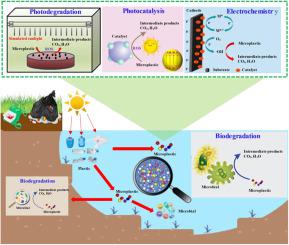Journal of Hazardous Materials ( IF 12.2 ) Pub Date : 2021-06-10 , DOI: 10.1016/j.jhazmat.2021.126377 Hao Du 1 , Yuqun Xie 2 , Jun Wang 3

|
Microplastics (MPs) pollution has become a global environmental concern because of their severe threat to biota. However, limited studies on the elimination of MPs pollution were reported. The conventional treatment methods were not suitable for MPs owing to their smaller size than plastic items. Hence many methods for MPs treatment have been examined. This review summarized the recently reported MPs degradation methods including AOPs (direct photodegradation, photocatalytic oxidation, and electrochemical oxidation) and biodegradation, corresponding degradation mechanism as well as current development state. The characteristics and limitations of each technique were discussed in detail. We found that all of them achieved almost satisfying degradation performance of MPs, but most of them exhibited that MPs can only be degraded partially into useful products or even CO2 and H2O under lab conditions. Given these, some recommendations for future research directions were proposed based on the knowledge gaps in these reported literatures. The aim of this review is to give a comprehensive introduction of several MPs degradation methods and acquaint the readers with the current research status of MPs degradation.
中文翻译:

微塑料降解方法及相应的降解机制:研究现状与未来展望
微塑料 (MPs) 污染已成为全球环境问题,因为它们对生物群构成严重威胁。然而,关于消除 MPs 污染的研究报告有限。传统的处理方法不适合 MP,因为它们比塑料制品小。因此,已经研究了许多 MPs 治疗方法。该综述总结了最近报道的MPs降解方法,包括AOPs(直接光降解、光催化氧化和电化学氧化)和生物降解,相应的降解机制以及目前的发展状况。详细讨论了每种技术的特点和局限性。我们发现它们都实现了几乎令人满意的 MPs 降解性能,2和 H 2 O 在实验室条件下。鉴于这些,基于这些报道文献中的知识差距提出了一些对未来研究方向的建议。本综述旨在全面介绍几种 MPs 降解方法,让读者了解 MPs 降解的研究现状。































 京公网安备 11010802027423号
京公网安备 11010802027423号